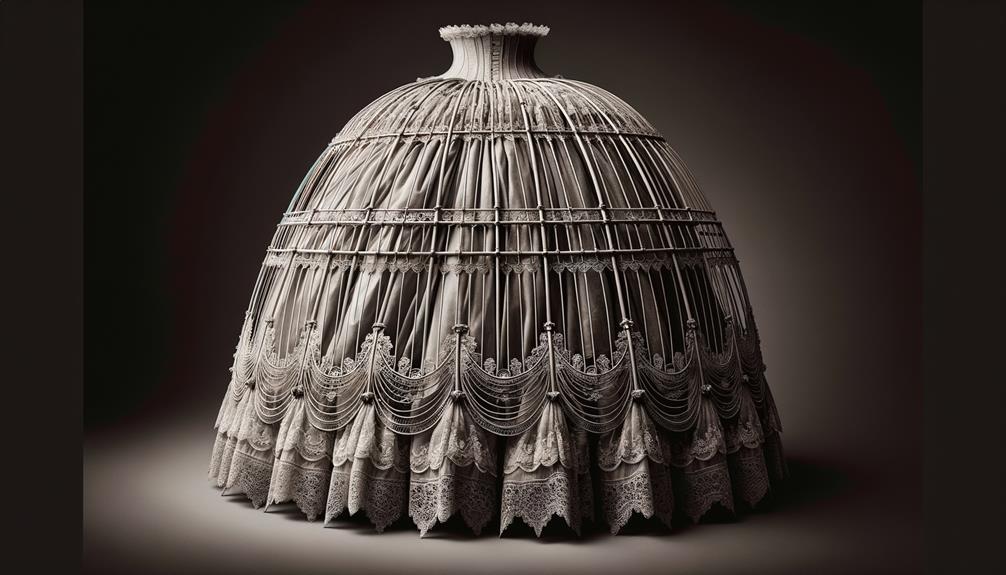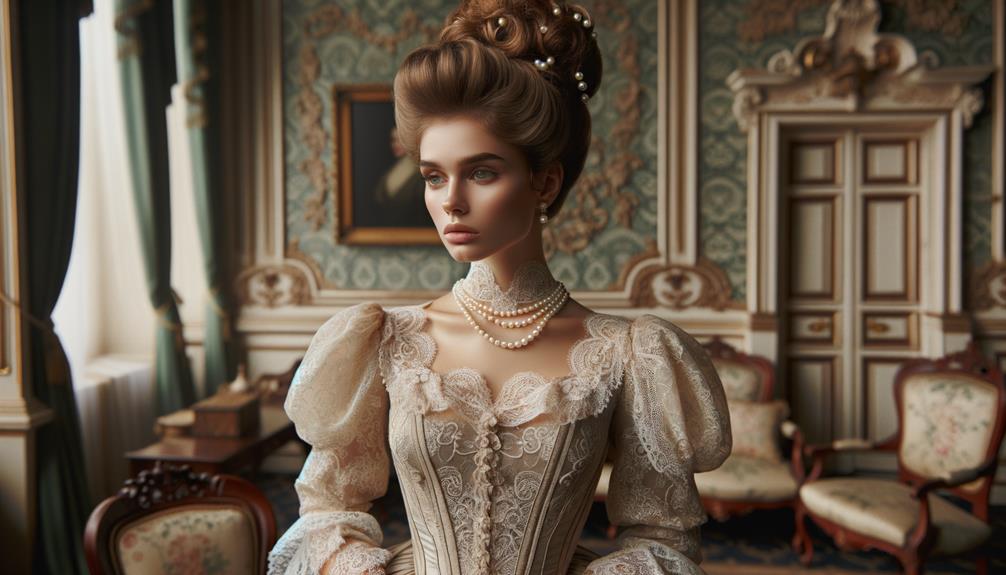Victorian women managed to balance style and practicality in their sportswear. Tennis players shifted to looser, shorter skirts for ease of movement. Croquet dresses became tighter and shorter, with vibrant colors. Boating outfits featured bold, striped fabrics and lengths that allowed for maneuverability. Equestrian wear also adapted, with split skirts and fitted jackets dominating the scene. Cycling apparel saw women ditch long skirts for bloomers and shorter skirts, making it safer and more practical. Each sport pushed the boundaries of traditional fashion, blending elegance and function. This fascinating evolution shows how Victorian women's sportswear kept up with their active lifestyles.
Tennis Attire
In the late 19th century, female tennis players began moving away from everyday clothing to specialized attire that enhanced their ability to move freely. This transformation was akin to a quiet revolution. Long skirts, once the norm, started to give way to shorter, looser designs. These garments weren't just about fashion; they were about reclaiming the freedom to move.
I often think about those early pioneers like Alice Marble and Gussie Moran, who dared to challenge societal expectations with their choice of attire. It wasn't merely practical; it was defiant. No longer restricted by heavy fabric and tight corsets, they moved with a grace and agility that must have felt liberating.
The fashion plates from the 1895 Delineator magazine still depicted long skirts, but change was on the horizon. Each alteration in the uniform marked a step towards greater practicality.
The evolution of tennis attire wasn't just about the game; it was about paving the way for functional sportswear for women. It showed that innovation often begins with small, incremental changes. Tennis, as a sport, became a symbol of this shift – where freedom of movement wasn't just desired; it was essential.
Croquet Fashion
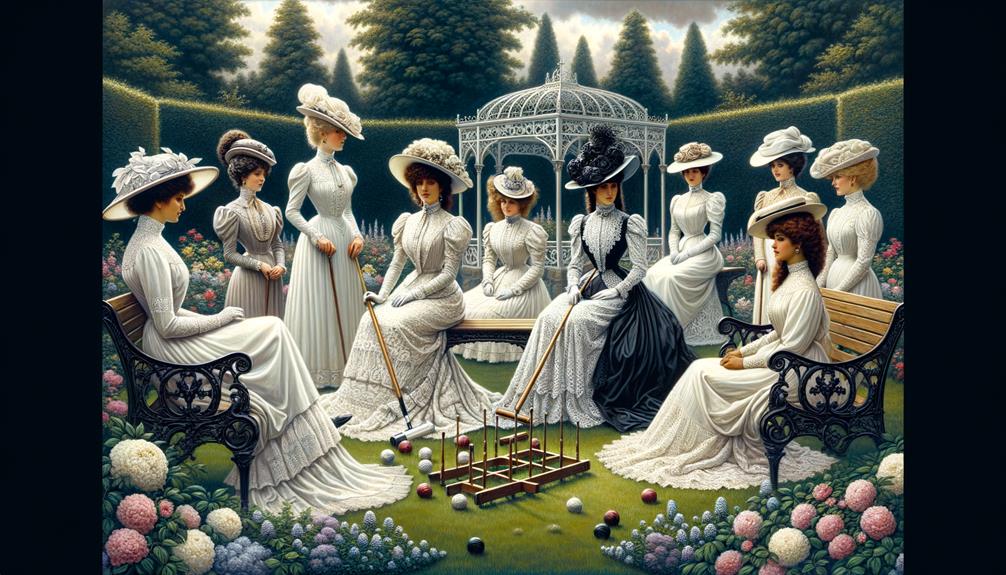
While tennis fashion was evolving, croquet attire followed suit, reflecting the growing demand for functionality and elegance in women's sportswear. The Victorian era saw croquet's popularity soar in the 1850s, offering women a socially acceptable outdoor activity. Yet, as they played, concerns about decorum emerged.
Croquet dresses needed to allow for movement. In the 1870s, recommendations included tight-fitting dresses and shorter skirts. These garments were practical, enabling the display of skill and grace. Bright colors became essential, adding vibrancy to the game's setting. These dresses were shorter than typical Victorian wear, making footwork visible, a subtle shift towards more practical fashion.
The evolution of croquet fashion paralleled that of Lawn Tennis attire. Both reflected a gradual shift away from restrictive clothing, embracing more functional designs. This change marked a significant moment in the Victorian era, where women's active pursuits began to shape their attire.
The croquet craze didn't just influence fashion; it symbolized a broader acceptance of women engaging in physical activities. This specialized sporting attire for women highlighted a blend of elegance and practicality, paving the way for future innovations in women's sportswear.
Boating Outfits
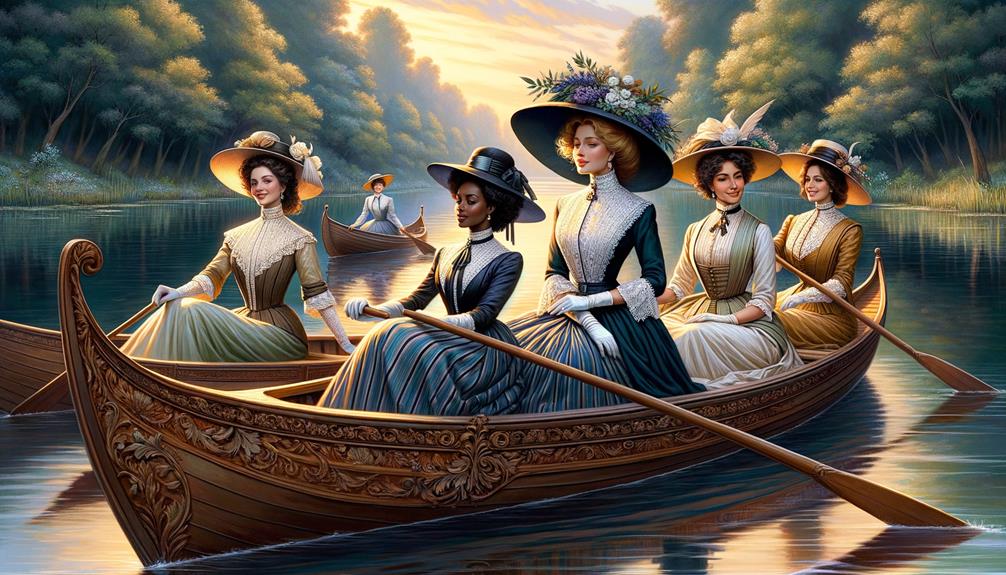
Boating attire during the Victorian era sought to balance fashionable trends with the practical needs of water-based activities. These ensembles merged style and usefulness, suiting the dynamic nature of yachting, canoeing, and cruising. The clothing retained the fashionable silhouette but featured shorter, more maneuverable lengths.
Bold colors and striking accessories were common, ensuring visibility and a touch of flair. Striped fabrics became a signature of boating fashion, adding vibrancy to the functional garments. The Metropolitan Museum of Art showcases various examples, illustrating how these outfits combined form and function.
Recommendations for proper boating dress included tight-fitting dresses to ensure modesty and freedom of movement, short skirts for ease of motion, bright colors for visibility on water, and protective wraps (known as 'coaching costumes') that blended practicality and style.
Women's increasing involvement in boating during the Victorian era challenged gender norms and expanded their public presence. Reflecting on these outfits, we can see a pivotal shift towards practicality without compromising elegance. The clothing of the time served as a record of the evolving roles and visibility of women in society.
Equestrian Wear
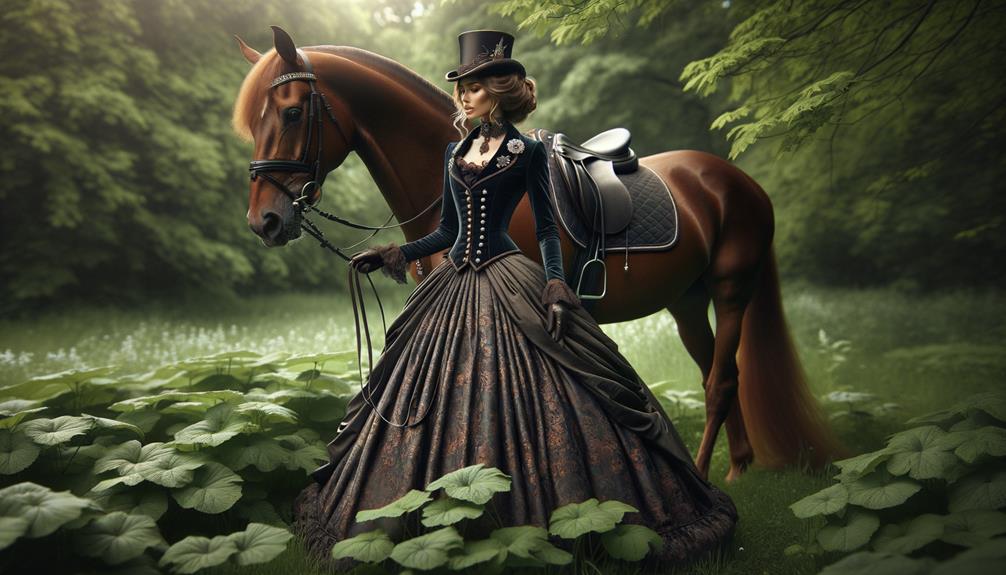
Just as boating attire balanced style with practicality, Victorian equestrian wear evolved to meet the demands of riding while maintaining elegance. I've noticed how the shift from everyday dress to specialized garments marked a significant change for women. Skirts became shorter and narrower, influenced by the sidesaddle style, allowing us to ride with ease.
The innovation didn't stop there. Split riding skirts, or 'bifurcated skirts', emerged in the late 19th century, offering greater mobility and freedom. Fitted jackets, canary breeches, and tall boots became the hallmark of the upper-class equestrian ensemble. These specialized riding habits were not merely functional; they were fashion statements in their own right.
| Garment | Functionality | Style Element |
|---|---|---|
| Fitted Jackets | Protection, warmth | Tailored silhouette |
| Split Riding Skirts | Mobility, freedom of movement | Bifurcated design |
| Canary Breeches | Comfort, flexibility | Bright color, snug fit |
| Tall Boots | Foot protection | Sleek leather finish |
Equestrian wear's evolution mirrored the changes seen in other sports for women, like playing tennis. The introduction of the safety bicycle in the 1880s further influenced this practical yet stylish attire. It was a time of transformation, where functionality began to coexist with fashion, paving the way for future innovations.
Cycling Apparel
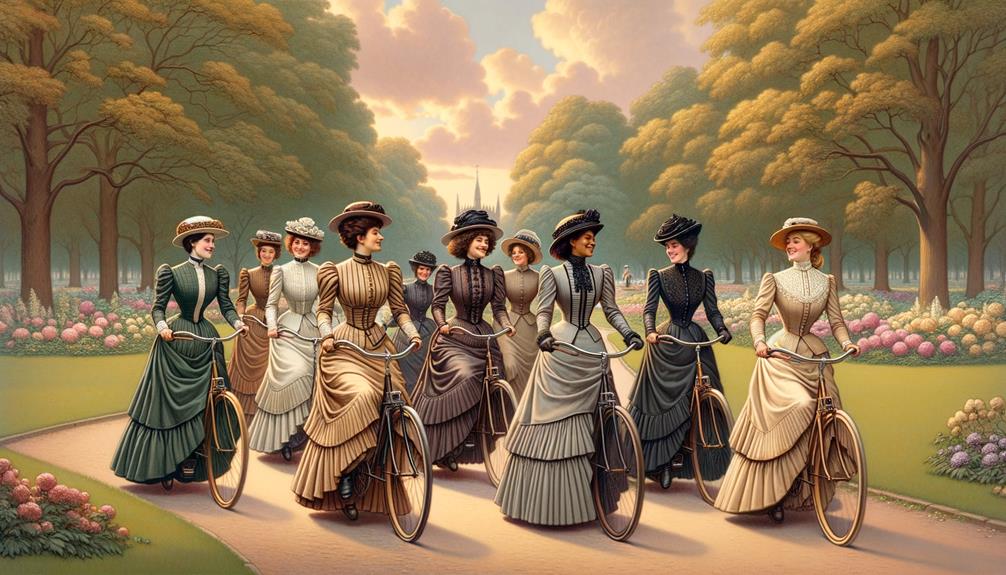
Cycling apparel in the late 19th century marked a major shift in women's sportswear, blending practicality with newfound freedom. As bicycles became a popular mode of transport and a beloved sporting activity, the type of dress women wore had to evolve.
Traditional long skirts were impractical and dangerous, leading to the development of specialized cycling attire.
I noticed these changes:
- Shorter skirts and bloomers allowed women to pedal freely without the risk of fabric getting caught.
- Divided skirts looked like a skirt but functioned as pants.
- A typical outfit included a middy top, an inside modesty piece, and gathered bloomer pants, often in practical materials like green wool.
- Shifting from heavy wool to lighter cotton and linen made the attire more comfortable and functional.
The bicycle craze of the Victorian and Edwardian eras didn't just change transportation; it challenged societal norms. Women on bicycles, dressed in these new, practical outfits, were symbols of independence and modernity. The evolution of cycling apparel wasn't merely about fashion – it was a statement of freedom and progress.
Frequently Asked Questions
What Is Active Sporting Attire?
Active sporting attire refers to clothing designed for physical activity. It's functional, comfortable, and allows freedom of movement. These garments have evolved to enhance performance, utilizing innovative fabrics and designs. I like how they combine practicality with style.
The clothing is meant to support people during various sports and fitness pursuits. It's typically made from breathable, moisture-wicking materials that help regulate body temperature. The designs often feature stretchy, flexible components that enable a wide range of motion.
Compared to everyday casual wear, active attire prioritizes mobility and durability over purely aesthetic considerations. While it can certainly be fashionable, the primary focus is on facilitating an active lifestyle and optimizing athletic performance.
How Is a Victorian Woman Supposed to Act?
In the 1800s, only a small fraction of women – around 3% – actively participated in sports. As a Victorian woman, I was expected to behave in a demure and refined manner, avoiding strenuous physical activities. The socially acceptable pastimes for ladies at the time were more sedentary, like playing croquet. Innovation and stepping outside of traditional feminine roles were generally frowned upon.
How to Dress Like a Victorian Woman?
When channeling the Victorian woman's aesthetic, I'd start with a corset over a light undergarment, then add a flowing petticoat and top it off with an elegant gown. The key is embracing the era's refined, detailed look, but finding ways to adapt it for modern comfort and practicality. Subtlety and sophistication are crucial, so I'd focus on quality fabrics and tailoring rather than over-the-top ornamentation.
What Would a Victorian Girl Wear?
A Victorian-era girl's wardrobe was a intricate affair. Her outfits often included corsets, petticoats, and layered dresses. This delicate ensemble conveyed a sense of constraint and grace, as she sought a measure of freedom through fashion. Her look was both intricate and stifling, a reflection of the era's ideals and social expectations.
Conclusion
Reflecting on Victorian sportswear, I can't help but be impressed by the determination and poise of women like Eliza, who played tennis in restrictive corsets and long skirts. She refused to let her attire hinder her spirit. Today, as I slip into my modern activewear, I feel a connection to those pioneering women. They paved the way, making the freedom of movement I enjoy possible. It's a reminder of how far we've come, yet how their resolve still echoes in every stride we take.



